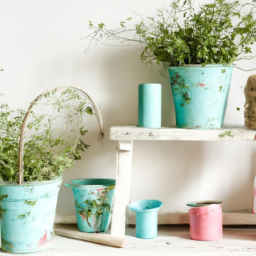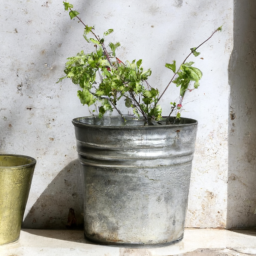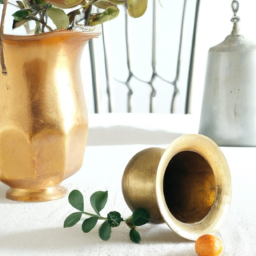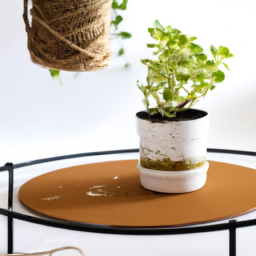
Hey there plant lovers! Are you ready to add a touch of vintage charm to your indoor or outdoor space? Well, you’re in luck because today we’re going to dive into the wonderful world of transforming vintage finds into stylish planters. Whether you’re a seasoned collector or just starting to explore the beauty of vintage treasures, this blog post will guide you through the process of repurposing unique items into stunning homes for your beloved plants. So, grab your gardening gloves and let’s get started on this creative adventure!
Transform Vintage Finds into Stylish Planters
1. Repurposing Vintage Containers for Unique Planters
Are you a lover of all things vintage? Do you have a passion for plants and gardening? If so, why not combine these two interests and transform vintage finds into stylish planters? Not only will you add a touch of nostalgia to your garden or indoor space, but you’ll also give new life to old items that may otherwise end up in a landfill. In this guide, we’ll take you through the step-by-step process of repurposing vintage containers into unique planters.
Choosing the Perfect Vintage Container
The first step in transforming vintage finds into stylish planters is finding the perfect container. Keep an eye out for unique and interesting items that can be repurposed as planters. Old watering cans, metal buckets, tea tins, wooden crates, and even vintage suitcases can all make excellent choices. Look for containers that have a bit of character and charm, as this will add to the overall aesthetic appeal of your planter.
When choosing a vintage container, it’s important to consider its size and shape. Ensure that it has enough space to accommodate the plant’s root system and allow for proper drainage. If the container doesn’t have any drainage holes, you can easily drill some yourself to prevent waterlogging.
Additionally, think about the material of the vintage container. Metal containers may require a liner to prevent rust and protect the roots from extreme temperatures. Wooden containers may need to be treated with a sealant to prevent rotting. Consider these factors when selecting your vintage find to ensure it is suitable for repurposing as a planter.
Preparing the Vintage Container
Once you have found the perfect vintage container, it’s time to prepare it for its new role as a planter. Start by cleaning the container thoroughly. Remove any dirt, dust, or debris that may have accumulated over the years. You can use soap and water or a gentle cleaning solution, depending on the material of the container. Be careful not to damage any delicate or painted surfaces during the cleaning process.
If the vintage container has any rust or peeling paint, you may want to consider giving it a fresh coat of paint. Choose a color that complements your plants and the overall aesthetic you want to achieve. Applying a coat of paint not only enhances the appearance of the planter but also helps protect the container from further deterioration.
Next, consider the drainage needs of your plants. If the vintage container doesn’t have any drainage holes, it’s crucial to create some. Use a drill with a suitable bit size to make holes in the bottom of the container. This will allow excess water to drain out and prevent root rot. Remember to place a tray or saucer underneath to catch the water.
Planting and Displaying Your Vintage Planter
Now that your vintage container is clean, painted, and prepared with drainage holes, it’s time to start planting! Choose plants that thrive in the conditions you can provide, whether it’s full sun, partial shade, or indoor lighting. Consider the size and shape of the container when selecting your plants. Taller plants work well in larger containers, while trailing or compact plants are ideal for smaller ones.
When planting, start by adding a layer of gravel or small rocks at the bottom of the container. This will further aid in drainage and prevent the roots from sitting in standing water. Fill the container with a suitable potting mix, leaving enough space for the plants to settle comfortably. Gently remove the plants from their nursery pots, loosen the roots, and place them in the container. Fill any gaps with additional potting mix, ensuring that the plants are securely positioned.
Once your vintage planter is planted, it’s time to decide where to display it. Whether it’s on a patio, balcony, or indoors, choose a spot that provides the appropriate lighting and temperature conditions for your plants. Vintage planters can add a unique touch to any space, so get creative with your placement. Consider grouping multiple planters together for a visually appealing display or incorporating them into existing garden features.
Remember to regularly water and care for your plants to ensure they thrive in their new vintage homes. Monitor the moisture levels, provide adequate sunlight, and fertilize as needed. With proper care, your repurposed vintage planters will become stunning focal points in your garden or indoor space.
Transforming vintage finds into stylish planters is a rewarding and creative way to add character to your garden or home. By repurposing old containers, you not only contribute to sustainable living but also create unique and eye-catching displays. So, start hunting for those vintage treasures and let your imagination run wild!

Creative Ideas for Turning Vintage Objects into Plant Holders
Are you a plant lover who also has a passion for vintage finds? If so, why not combine these two interests and transform your vintage objects into stylish plant holders? Not only will this add a unique touch to your home decor, but it will also give your plants a new and interesting home. In this article, we will explore some creative ideas for turning vintage objects into plant holders. So, let’s dive in and get inspired!
1. Teacup Planters
Teacups are not only meant for sipping tea; they can also serve as adorable plant holders. Look for vintage teacups with interesting patterns or colors that catch your eye. Fill them with a small amount of potting soil and plant your favorite succulents or small indoor plants. These teacup planters will add a touch of whimsy to any space, whether placed on a windowsill or arranged on a shelf.
If you want to take it a step further, consider creating a teacup planter arrangement. Find a vintage teacup set with matching saucers and arrange them in a group. Plant different types of plants in each cup to create a visually appealing display. This is a great way to showcase your plant collection while adding a vintage touch to your home.
Remember to choose teacups with drainage holes or create your own by carefully drilling a small hole in the bottom. This will ensure proper drainage and prevent water from accumulating, which can lead to root rot.
2. Suitcase Planters
Old suitcases can find a new purpose as unique plant holders. Look for vintage suitcases with interesting textures or patterns that match your style. Open the suitcase and line it with a plastic sheet or a waterproof liner to protect it from water damage. Fill it with potting soil and plant your favorite plants, such as ferns or trailing vines.
Suitcase planters can be placed on the floor, a table, or even hung on the wall for a truly eye-catching display. Consider using multiple suitcases of different sizes and stacking them to create a vertical garden. This will not only save space but also create a stunning focal point in your home.
When watering your plants, be mindful of the suitcase’s material. Some vintage suitcases may not be water-resistant, so it’s best to remove the plants and water them separately to avoid any damage.
3. Mason Jar Herb Garden
Mason jars are a versatile and popular choice for creating vintage-inspired plant holders. They can be easily transformed into herb gardens, adding both beauty and functionality to your kitchen. Start by finding vintage mason jars in different sizes. Clean them thoroughly and remove any labels or residue.
Fill each mason jar with potting soil and plant your favorite herbs, such as basil, rosemary, or thyme. Label each jar with the herb’s name using vintage-style tags or labels. Arrange the mason jars on a windowsill or hang them using twine for a charming herb garden display.
Remember to place the mason jars in a spot that receives enough sunlight for the herbs to thrive. Also, ensure proper drainage by adding a layer of small rocks or pebbles at the bottom of each jar.
These are just a few creative ideas for transforming vintage objects into stylish plant holders. Let your imagination run wild and experiment with different vintage finds to create unique plant displays that reflect your personal style. Remember to care for your plants properly by providing them with adequate sunlight, water, and nutrients. Happy gardening!

Transforming Vintage Discoveries into Trendy Plant Containers
Are you a fan of vintage finds and looking for creative ways to incorporate them into your home decor? Transforming vintage discoveries into stylish planters is a fantastic way to add a unique touch to your indoor or outdoor space. Not only does it give new life to old items, but it also adds a touch of greenery that can brighten up any room. In this guide, we’ll take you through the step-by-step process of transforming vintage finds into trendy plant containers.
Finding the Perfect Vintage Pieces
The first step in transforming vintage finds into stylish planters is to find the perfect pieces to work with. Visit local thrift stores, flea markets, or even online marketplaces to hunt for unique vintage items that catch your eye. Look for items with interesting shapes, textures, and patterns that can serve as a base for your plant containers. Some popular vintage finds that work well as planters include old teapots, metal buckets, wooden crates, and ceramic bowls.
When selecting your vintage finds, consider the size and shape of the plants you plan to use. Ensure that the item you choose has enough space to accommodate the roots and growth of your plants. It’s also important to check for any damages or cracks that may affect the functionality of the planter. Once you’ve found the perfect vintage pieces, it’s time to move on to the next step.
Preparing and Repurposing the Vintage Finds
Before you can transform your vintage finds into plant containers, it’s crucial to prepare and repurpose them accordingly. Start by cleaning the items thoroughly to remove any dirt or grime. Use mild soap and water or appropriate cleaning agents depending on the material of the vintage piece. Ensure that the item is completely dry before moving on to the next step.
If your vintage find has any existing paint or finish, you may choose to either preserve it or give it a fresh coat of paint. For a more rustic look, consider sanding the surface lightly to expose the natural textures of the item. If you prefer a more polished appearance, choose a paint color that complements your overall decor theme. Remember to use paint that is suitable for the material of the vintage find.
Once you’ve cleaned and repurposed your vintage finds, it’s time to make them suitable for housing plants. If the item doesn’t have any drainage holes, you’ll need to create them to ensure proper water drainage for your plants. Use a drill or a similar tool to carefully create small holes at the bottom of the container. This step is crucial to prevent waterlogging and root rot.
Planting and Styling Your Vintage Plant Containers
With your vintage finds cleaned, repurposed, and prepared, it’s finally time to transform them into trendy plant containers. Start by adding a layer of gravel or small pebbles at the bottom of the container. This layer will help with drainage and prevent the roots from sitting in excess water. Next, fill the container with a well-draining potting mix, leaving enough space for the plant’s roots.
Choose plants that are suitable for the lighting conditions of your space and the size of the planter. Succulents and cacti are great options for vintage teapots or small ceramic bowls, while larger containers can accommodate a variety of plants such as ferns, pothos, or snake plants. Gently remove the plants from their nursery pots, loosen the roots, and place them in the prepared vintage container.
Once your plants are in place, it’s time to add the finishing touches and style your vintage plant containers. Consider adding decorative elements such as moss, small figurines, or pebbles to enhance the overall aesthetic appeal. Experiment with different arrangements and groupings to create visually pleasing displays. Remember to place your vintage planters in appropriate locations based on the lighting and care requirements of the plants you’ve chosen.
Transforming vintage finds into stylish plant containers is a fun and creative way to incorporate unique pieces into your home decor. By following these step-by-step instructions, you can breathe new life into old items while adding a touch of nature to your living space. So, start hunting for those vintage treasures and let your creativity flourish!
Here’s the Summary Snapshot
Are you a fan of vintage treasures and greenery? If so, you’re in for a treat! In this blog post, we’ll show you how to transform your vintage finds into stylish planters that will add a unique touch to your home decor.
Vintage items have a certain charm and character that can’t be replicated with modern pieces. By repurposing them as planters, you not only give them a new lease on life but also create a stunning focal point for your plants. Imagine an old teapot overflowing with vibrant flowers or a retro suitcase filled with cascading greenery – the possibilities are endless! To get started, all you need is a vintage item of your choice, some basic gardening tools, and a bit of creativity. Don’t worry if you’re not a seasoned gardener – we’ll guide you through the process step by step. So, dust off those forgotten treasures and let’s turn them into eye-catching planters that will make your friends green with envy!
Frequently Asked Questions (FAQ):
Q1: How can I transform vintage finds into stylish planters?
A1: Transforming vintage finds into stylish planters is a fun and creative way to add a unique touch to your indoor or outdoor space. To get started, you can follow these steps:
- Choose a vintage item: Look for items like old teapots, tin cans, wooden crates, or even old shoes that can be repurposed as planters.
- Clean and prepare the item: Make sure to clean the vintage item thoroughly and remove any dirt or debris. If needed, you can also sand or paint the item to give it a fresh look.
- Add drainage holes: Depending on the material of the vintage find, you may need to drill or poke holes at the bottom to ensure proper drainage for your plants.
- Fill with soil and plant: Fill the vintage planter with well-draining potting soil and carefully plant your chosen greenery or flowers.
- Display and enjoy: Find the perfect spot for your transformed vintage planter, whether it’s on a windowsill, a shelf, or in your garden. Sit back and enjoy the unique charm it brings to your space!
Q2: What are some creative ideas for vintage planters?
A2: There are countless creative ideas for transforming vintage finds into planters. Here are a few examples to spark your imagination:
- Teacup planters: Use vintage teacups or teapots as adorable planters for small succulents or herbs.
- Toolbox planters: Repurpose an old toolbox by adding some soil and planting flowers or trailing plants.
- Boot or shoe planters: Give old boots or shoes a new life by filling them with soil and adding colorful flowers.
- Drawer planters: Use old wooden drawers as rustic, multi-level planters for a variety of plants.
- Repurposed tin cans: Clean and paint tin cans to create charming planters for small plants or herbs.
Q3: How can I ensure proper drainage in vintage planters?
A3: Proper drainage is essential for the health of your plants, even in vintage planters. Here are a few tips to ensure good drainage:
- Add drainage holes: If your vintage find doesn’t already have drainage holes, use a drill or a hammer and nail to create several small holes at the bottom.
- Use a layer of rocks or pebbles: Place a layer of rocks or pebbles at the bottom of the planter before adding soil. This will help prevent water from pooling at the roots.
- Choose well-draining soil: Opt for a high-quality potting mix that provides good drainage. Avoid heavy garden soil that can retain too much water.
- Monitor watering: Be mindful not to overwater your plants. Check the moisture level of the soil regularly and adjust your watering schedule accordingly.
Q4: Can vintage planters be used for both indoor and outdoor plants?
A4: Absolutely! Vintage planters can be used to showcase both indoor and outdoor plants. However, it’s important to consider the material and durability of the vintage find. Some vintage items may be more suitable for indoor use, while others can withstand outdoor conditions.
If you plan to use a vintage planter outdoors, make sure it is made of weather-resistant materials or apply a protective sealant to prevent damage from the elements. For indoor use, any vintage find that can hold soil and has proper drainage can be transformed into a stylish planter.
Q5: How can I maintain vintage planters?
A5: Maintaining vintage planters is relatively simple and will help keep them looking their best. Here are a few maintenance tips:
- Regularly check for water drainage: Ensure that the drainage holes are not clogged and water is flowing freely.
- Monitor plant health: Keep an eye on your plants for any signs of pests, diseases, or nutrient deficiencies. Take appropriate action to address any issues promptly.
- Prune and trim: Regularly prune and trim your plants to maintain their shape and prevent overgrowth. This will also help ensure they don’t outgrow the vintage planter.
- Clean the planter: Occasionally clean the vintage planter by wiping away any dust or dirt. For

Lisa Chen is a seasoned indoor gardening expert and the author of several bestselling books on the topic. With a background in horticulture and urban farming, Lisa is dedicated to helping urban dwellers embrace the joys of cultivating green spaces indoors. Her detailed guides and hands-on tips empower readers to transform their living spaces into thriving plant sanctuaries.



